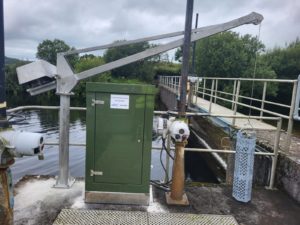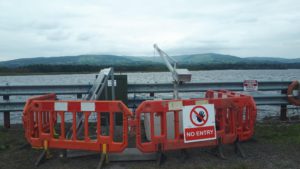
Blog
The Evolution of Remote Surface Water Monitoring: What You Need to Know
The Evolution of Remote Surface Water Monitoring: What You Need to Know highlights how our rivers, lakes, reservoirs, and coastal areas are closely tied to environmental stability, public well-being, biodiversity, and key economic sectors such as agriculture and industry. Traditionally, monitoring the quality of these vital resources has relied on manual sampling and laboratory analysis. Whilst this method has long provided a baseline, its limitations including intermittent data, high labour demands, and delayed responses to emerging threats, are becoming increasingly clear in today’s rapidly changing world.
As the complexity of environmental challenges intensifies and regulatory scrutiny tightens, technological advancements have ushered in a transformative era for water quality management. Remote surface water monitoring systems now offer the capability to collect, transmit, and analyse high-resolution water quality data in near real-time. This evolution is fundamentally changing how stakeholders gain insights into and protect our precious waterways.
In this article, we will delve into the journey of remote surface water monitoring, exploring the technological innovations that are shaping the field today and outlining the practical considerations essential for the successful implementation of a robust monitoring programme.
What Is Remote Surface Water Monitoring?
At its core, remote surface water monitoring involves the deployment of in-situ sensors and sophisticated communication technologies to continuously measure a range of water quality parameters without the need for physical sample collection. These systems are typically strategically positioned in fixed locations within rivers, lakes, reservoirs, estuaries, or coastal zones. The collected data is then transmitted wirelessly to a central platform, where it can be accessed, analysed, and acted upon by relevant stakeholders.
A range of critical parameters are commonly monitored, including:
- pH: A fundamental indicator of water’s acidity or alkalinity, influencing chemical and biological processes.
- Turbidity: A measure of the water’s clarity, indicating the presence of suspended particles such as sediment, algae, or organic matter.
- Dissolved Oxygen (DO): Essential for the respiration of aquatic organisms, low levels can indicate pollution or excessive organic matter decomposition.
- Chlorine Levels: Particularly important near water treatment plant discharges to ensure effective disinfection whilst avoiding harmful residuals.
- Conductivity: A proxy for the concentration of dissolved salts and minerals, useful for detecting salinity intrusion or pollution events.
- Nutrients: Including key compounds like nitrates, ammonia, and phosphates, which at elevated levels can contribute to eutrophication and harmful algal blooms.
More advanced systems may also incorporate sensors for parameters such as temperature, redox potential, and certain heavy metal concentrations, providing an even more comprehensive understanding of water quality dynamics.
How Remote Surface Water Monitoring Technology Has Advanced
Until relatively recently, many water quality monitoring programmes primarily relied on periodic spot sampling. Field teams would manually collect water samples at pre-determined intervals for subsequent laboratory analysis. Whilst this method remains important for certain regulatory requirements and detailed chemical assessments, it often lacks the temporal and spatial granularity needed for the timely detection of transient pollution events or the comprehensive understanding of dynamic aquatic ecosystems.
The landscape of water quality monitoring has been significantly transformed by technological innovation. Modern monitoring systems now incorporate:
- Multiparameter Probes: These sophisticated devices integrate multiple sensors into a single unit, allowing for the simultaneous measurement of numerous water quality indicators.
- Advanced Optical Sensors: Employing techniques like UV-Vis spectrometry, these sensors enable the chemical-free analysis of various organic and inorganic compounds directly in the water body, reducing the need for reagents and laboratory processing. For instance, advanced optical sensors integrated into multiparameter sondes can now detect a wider spectrum of organic pollutants in real-time, providing early warnings for drinking water sources.
- Edge Computing: On-site data processing capabilities allow for immediate analysis of sensor readings, enabling the identification of anomalies and triggering alerts without the need for constant cloud connectivity. Sophisticated algorithms embedded in edge computing devices can now differentiate between natural fluctuations in water parameters and potential contamination events, reducing false alarms and improving response efficiency.
- Versatile Telecommunication Modules: Utilising cellular, satellite, or low-power wide-area network (LPWAN) protocols, these modules ensure reliable and efficient data transmission from remote monitoring stations. The ability to deploy low-power wide-area networks (LPWAN) has significantly expanded the reach of monitoring programmes into previously inaccessible upland catchments, providing crucial data on headwater quality.
- Cloud-Based Dashboards: Secure online platforms provide intuitive interfaces for live data visualisation, trend analysis, historical data review, and automated report generation.
 Some cutting-edge systems can now continuously measure over 30 water quality parameters without requiring chemical reagents, frequent manual calibration, or laboratory analysis. These advancements not only enhance data accuracy and frequency but also facilitate autonomous operation over extended periods, making them ideal for remote or difficult-to-access locations.
Some cutting-edge systems can now continuously measure over 30 water quality parameters without requiring chemical reagents, frequent manual calibration, or laboratory analysis. These advancements not only enhance data accuracy and frequency but also facilitate autonomous operation over extended periods, making them ideal for remote or difficult-to-access locations.
Furthermore, the integration of machine learning and predictive analytics is becoming increasingly prevalent. These powerful tools can help identify subtle anomalies in the data, suggest potential sources of pollution based on historical patterns, or even anticipate environmental events such as harmful algal blooms or periods of hypoxia (low dissolved oxygen).
Why Remote Monitoring Matters
The adoption of remote monitoring systems offers a compelling array of advantages, particularly when contrasted with traditional, manual monitoring methodologies:
- Enhanced Accuracy and Data Resolution: Continuously deployed sensors can capture measurements at significantly higher frequencies – ranging from intervals of mere minutes to hourly readings. This allows for a much more granular understanding of short-term variations and the identification of long-term trends that might be missed by infrequent manual sampling.
- Expedited Detection of Pollution Incidents: Real-time data transmission capabilities mean that pollution events or other water quality anomalies can be identified almost immediately. This rapid detection enables swift responses, minimising potential environmental damage and regulatory repercussions. The potential economic impacts of delayed pollution detection on sensitive ecosystems or downstream water users can be substantial.
- Improved Operational Efficiency and Safety: By significantly reducing the need for routine site visits and manual sample collection, remote monitoring systems lower operational costs associated with fieldwork, personnel time, and laboratory analyses. Moreover, they minimise potential health and safety risks for field staff, particularly in hazardous or difficult-to-access locations.
- Streamlined Compliance and Reporting: Many modern remote monitoring platforms offer features for the automatic generation of regulatory reports, simplifying the process of demonstrating compliance with environmental regulations such as the Water Framework Directive standards.
- Data-Driven Environmental Management: The ability to visualise water quality trends over extended periods provides invaluable insights for understanding the impacts of various factors such as land use changes, climate variability, infrastructure development, and seasonal fluctuations on water resources. This data-driven approach empowers organisations to make more informed decisions regarding water resource management and environmental protection. Continuous data also contributes to a better understanding of the long-term impacts of climate change on water availability and quality.
Practical Considerations for Implementation
Whilst remote monitoring technologies are becoming increasingly accessible and cost-effective, successful deployment necessitates careful planning and decision-making tailored to specific contexts. Key factors to consider include:
- Clearly Defined Monitoring Objectives: What are the primary goals of your monitoring programme? Are you aiming for early warning systems for pollution events, compliance monitoring against regulatory standards, comprehensive catchment characterisation, or a combination of these objectives? The specific objectives will directly influence the selection of appropriate sensors, the required data resolution and frequency, and the necessary platform integration capabilities.
- Understanding Site Characteristics: The physical attributes of the chosen monitoring site – including water flow velocity, water depth, degree of exposure to the elements, and site accessibility for installation and maintenance – will dictate the optimal hardware configuration, power supply requirements (e.g., solar, battery, or mains), and installation methodologies.
- Seamless Data Integration: Consider the compatibility of the chosen monitoring system with existing Supervisory Control and Data Acquisition (SCADA), telemetry, or other asset management systems. Many modern platforms offer REST APIs or adhere to other open data standards to facilitate seamless integration and data sharing.
- Prioritising Maintenance and Longevity: Whilst modern systems are engineered for increasingly low-maintenance operation, consider factors such as sensor fouling potential at the deployment site and the expected lifespan of the equipment. Features like self-cleaning sensors, automated calibration routines, and remote diagnostic capabilities are becoming more common, reducing the ongoing burden on field teams.
- Robust Data Security and Governance: With the increasing digitisation of environmental data, ensuring data integrity and security is paramount. Cloud-based platforms should provide secure data storage infrastructure, robust user access control mechanisms, and comprehensive audit trails to maintain the traceability of all measurements. The implementation of appropriate data management systems and analytical tools is crucial for transforming raw data into actionable insights. Furthermore, skilled personnel are needed to effectively deploy, maintain, and interpret the data generated by these systems.
Real-World Examples of Application
Remote water quality monitoring systems are now being deployed across a diverse range of applications, including:
- Catchment Management Programmes: Focused on understanding and mitigating nutrient run-off from agricultural land and reducing sediment load in rivers and streams. In a recent project focused on a large agricultural catchment, the deployment of a network of remote sensors measuring nutrient levels allowed environmental agencies to pinpoint sources of excessive run-off and work with farmers to implement targeted mitigation strategies, resulting in a significant improvement in downstream water quality within two years.
- Urban Water Networks: Monitoring the effectiveness of drinking water treatment processes and detecting combined sewer overflows that can impact receiving water bodies.
- Industrial Discharges: Ensuring continuous compliance with discharge consents and providing early warning of any anomalous releases.
- Recreational Water Bodies: Maintaining safe and healthy conditions for swimming, boating, and other public uses by monitoring for parameters like bacteria levels and harmful algal blooms.
- Reservoir Management: Providing critical data to inform strategies for mitigating algal blooms through aeration or other interventions, and for optimising water releases.

One established provider of water monitoring solutions, Badger Meter, has highlighted the significant role these technologies play in enabling a transition from reactive responses to proactive water quality management by providing operators with continuous visibility into water conditions.
Looking Ahead
The ongoing shift towards real-time, remote water quality monitoring is an integral part of a broader movement towards developing smarter and more resilient environmental infrastructure. As digital technologies become increasingly embedded in water management practices, we can anticipate further significant advancements in areas such as predictive analytics for forecasting water quality conditions, the development of adaptive management strategies informed by continuous data, and the integration of ecosystem-level modelling to understand complex interactions. The increasing integration of Internet of Things (IoT) devices, the potential for citizen science initiatives to contribute valuable data streams, ongoing improvements in battery technology for extended autonomous deployments, and the growing adoption of digital twin technologies in water resource management all point towards an increasingly connected and data-driven future for water quality monitoring.
Remote surface water monitoring plays a pivotal role in facilitating sustainable decision-making – not only for meeting regulatory obligations but also for enhancing public trust in water resource management, safeguarding biodiversity in aquatic ecosystems, and bolstering resilience to the impacts of climate change.
In Summary
Remote surface water monitoring provides an efficient, reliable, and data-rich paradigm for understanding and effectively managing the quality of our surface water resources. Through the provision of continuous measurements, real-time data reporting, and a reduced reliance on labour-intensive site visits, these systems offer substantial advantages for a diverse range of stakeholders, including local authorities, water utilities, environmental agencies, and industrial operators.
As these technologies continue to mature, become more integrated, and offer increasingly sophisticated analytical capabilities, remote monitoring is poised to become a fundamental cornerstone of environmental protection efforts in Ireland, the UK, and across the globe.
This article draws upon sector insights from established solution providers like Badger Meter and other leading environmental monitoring platforms, reflecting best practices and the evolving landscape of water quality monitoring.
If you are interested in exploring how to enhance your organisation’s approach to surface water monitoring, Coftec’s experienced team can provide expert guidance and solutions tailored to your specific operational needs and the relevant regulatory context.
Contact us today to discuss your water monitoring needs.
